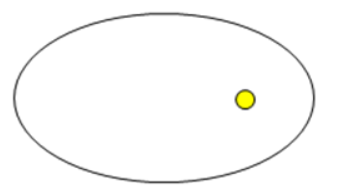15.3: Kepler’s Statement of his Three Laws
( \newcommand{\kernel}{\mathrm{null}\,}\)
1. The planets all move in elliptical orbits with the Sun at one focus.

2. As a planet moves in its orbit, the line from the center of the Sun to the center of the planet sweeps out equal areas in equal times, so if the area SAB(with curved side AB) equals the area SCD, the planet takes the same time to move from A to B as it does from CtoD.

3. The time it takes a planet to make one complete orbit around the sun T (one planet year) is related to the length of the semimajor axis of the ellipse a:
T2∝a3
In other words, if a table is made of the length of year T for each planet in the Solar System, and the length of the semimajor axis of the ellipse a, and T2/a3 is computed for each planet, the numbers are all the same.
These laws of Kepler’s are precise (apart from tiny relativistic corrections, undetectable until centuries later) but they are only descriptive—Kepler did not understand why the planets should behave in this way. Newton’s great achievement was to prove that all this complicated behavior followed from one simple law of attraction.


